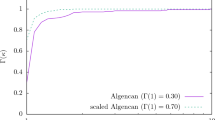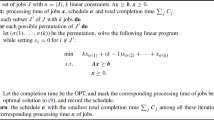Abstract
This paper aims to globally solve a generalized affine fractional program problem (GAFPP). Firstly, by introducing some outer space variables and performing equivalent transformations, we can derive the equivalence problem (EP) of the GAFPP. Secondly, by constructing a novel linear relaxation method, we can deduce the affine relaxation problem (ARP) of the EP. Next, by solving the ARP to compute the lower bound, we propose a new outer space branch-and-bound algorithm for tackling the GAFPP. Then, the global convergence of the algorithm is proved, and the computational complexity of the algorithm in the worst case is analyzed. Finally, numerical experimental results are reported to illustrate the effectiveness of the algorithm.
Similar content being viewed by others
Data Availability Statement
The data supporting this study can be obtained based on reasonable requests from the corresponding author.
References
Barros, A.I., Frenk, J.B.G.: Generalized fractional programming and cutting plane algorithms. J. Optim. Theory Appl. 87, 103–120 (1995)
Benson, H.P.: A simplicial branch and bound duality-bounds algorithm for the linear sum-of-ratios problem. Eur. J. Oper. Res. 182(2), 597–611 (2007)
Charnes, A., Cooper, W.: Programming with linear fractional functionals. Nav. Res. Log. Q. 9(3–4), 181–186 (1962)
Choi, C., Bricker, D.L.: Effectiveness of a geometric programming algorithm for optimization of machining economics models. Comput. Oper. Res. 23(10), 957–961 (1996)
Das, K., Roy, T.K., Maiti, M.: Multi-item inventory model with under imprecise objective and restrictions: a geometric programming approach. Prod. Plan. Control 11(8), 781–788 (2000)
Depetrini, D., Locatelli, M.: Approximation algorithm for linear fractional-multiplicative problems. Math. Program. 128, 437–443 (2011)
Gao, Y., Xu, C., Wang, Y., Zhang, L.: A new two-level linear relaxed bound method for geometric programming problems. Appl. Math. Comput. 164(1), 117–131 (2005)
Gao, Y., Xu, C., Yan, Y.: An outcome-space finite algorithm for solving linear multiplicative programming. Appl. Math. Comput. 179(2), 494–505 (2006)
Jiao, H.: A branch and bound algorithm for globally solving a class of nonconvex programming problems. Nonlinear Anal.-Theor. 70(2), 1113–1123 (2009)
Jiao, H., Guo, Y., Shen, P.: Global optimization of generalized linear fractional programming with nonlinear constraints. Appl. Math. Comput. 183(2), 717–728 (2006)
Jiao, H., Li, B.: Solving min-max linear fractional programs based on image space branch-and-bound scheme. Chaos Soliton Fract. 164, 112682 (2022)
Jiao, H., Liu, S.: Global optimization algorithm for a generalized linear multiplicative programming. J. Appl. Math. Comput. 40, 551–568 (2012)
Jiao, H., Liu, S.: Range division and compression algorithm for quadratically constrained sum of quadratic ratios. Comput. Appl. Math. 36, 225–247 (2017)
Jiao, H.W., Liu, S.Y.: A practicable branch and bound algorithm for sum of linear ratios problem. Eur. J. Oper. Res. 243(3), 723–730 (2015)
Jiao, H.W., Liu, S.Y., Zhao, Y.F.: Effective algorithm for solving the generalized linear multiplicative problem with generalized polynomial constraints. Appl. Math. Model. 39(23–24), 7568–7582 (2015)
Jiao, H., Ma, J.: An efficient algorithm and complexity result for solving the sum of general affine ratios problem. Chaos Soliton Fract. 164, 112701 (2022)
Jiao, H., Ma, J., Shang, Y.: Image space branch-and-bound algorithm for globally solving minimax linear fractional programming problem. Pac. J. Optim. 18(1), 195–212 (2022)
Jiao, H., Ma, J., Shen, P., Qiu, Y.: Effective algorithm and computational complexity for solving sum of linear ratios problem. J. Ind. Manag. Optim. 19(6), 4410–4427 (2023)
Jiao, H., Shang, Y.: Two-level linear relaxation method for Generalized linear fractional programming. J. Oper. Res. Soc. China 11(3), 569–594 (2023)
Jiao, H., Shang, Y., Chen, R.: A potential practical algorithm for minimizing the sum of affine fractional functions. Optimization 72(6), 1577–1607 (2023)
Jiao, H., Shang, Y., Wang, W.: Solving generalized polynomial problem by using new affine relaxed technique. Int. J. Comput. Math. 99(2), 309–331 (2022)
Jiao, H., Wang, W., Shang, Y.: Outer space branch-reduction-bound algorithm for solving generalized affine multiplicative problem. J. Comput. Appl. Math. 419, 114784 (2023)
Jiao, H., Wang, W., Yin, J., Shang, Y.: Image space branch-reduction-bound algorithm for globally minimizing a class of multiplicative problems. RAIRO-Oper. Res. 56(3), 1533–1552 (2022)
Lin, J.Y., Chen, H.J., Sheu, R.L.: Augmented lagrange primal-dual approach for generalized fractional programming problems. J. Ind. Manag. Optim. 9(4), 723–741 (2013)
Maranas, C.D., Floudas, C.A.: Global optimization in generalized geometric programming. Comput. Chem. Eng. 21(4), 351–369 (1997)
Nesterov, Y.E., Nemirovskii, A.S.: An interior-point method for generalized linear-fractional programming. Math. Program. 69, 177–204 (1995)
Ozkok, B.A.: An iterative algorithm to solve a linear fractional programming problem. Comput. Ind. Eng. 140, 106234 (2020)
Pei, Y., Zhu, D.: Global optimization method for maximizing the sum of difference of convex functions ratios over nonconvex region. J. Appl. Math. Comput. 41(1–2), 153–169 (2013)
Ryoo, H.S., Sahinidis, N.V.: Global optimization of multiplicative programs. J. Glob. Optim. 26, 387–418 (2003)
Shen, P.: Linearization method of global optimization for generalized geometric programming. Appl. Math. Comput. 162(1), 353–370 (2005)
Shen, P., Bai, X., Li, W.: A new accelerating method for globally solving a class of nonconvex programming problems. Nonlinear Anal.-Theor. 71(7–8), 2866–2876 (2009)
Shen, P., Huang, B., Wang, L.: Range division and linearization algorithm for a class of linear ratios optimization problems. J. Comput. Appl. Math. 350, 324–342 (2019)
Shen, P., Jiao, H.: A new rectangle branch-and-pruning approach for generalized geometric programming. Appl. Math. Comput. 183(2), 1027–1038 (2006)
Shen, P., Jiao, H.: Linearization method for a class of multiplicative programming with exponent. Appl. Math. Comput. 183(1), 328–336 (2006)
Shen, P., Lu, T.: Regional division and reduction algorithm for minimizing the sum of linear fractional functions. J. Inequal. Appl. 2018(1), 1–19 (2018)
Shen, P., Zhang, K.: Global optimization of signomial geometric programming using linear relaxation. Appl. Math. Comput. 150(1), 99–114 (2004)
Shen, P., Wang, C.: Global optimization for sum of generalized fractional functions. J. Comput. Appl. Math. 214(1), 1–12 (2008)
Shen, P., Zhang, T., Wang, C.: Solving a class of generalized fractional programming problems using the feasibility of linear programs. J. Inequal. Appl. 2017(1), 1–16 (2017)
Stancu-Minasian, I.M.: Fractional Programming: Theory, Methods and Applications. Kluwer, Dordrecht (1997)
Thi Hoai Phuong, N., Tuy, H.: A unified monotonic approach to generalized linear fractional programming. J. Glob. Optim. 26, 229–259 (2003)
Wang, C., Deng, Y., Shen, P.: A novel convex relaxation-strategy-based algorithm for solving linear multiplicative problems. J. Comput. Appl. Math. 407, 114080 (2022)
Wang, Y., Liang, Z.: A deterministic global optimization algorithm for generalized geometric programming. Appl. Math. Comput. 168(1), 722–737 (2005)
Watanabe, H.: Bond portfolio optimization problems and their applications to index tracking: a partial optimization approach. J. Oper. Res. Soc. Jpn. 39(3), 295–306 (1996)
Wang, C., Shen, P.: A global optimization algorithm for linear fractional programming. Appl. Math. Comput. 204(1), 281–287 (2008)
Wang, Y., Shen, P., Liang, Z.: A branch-and-bound algorithm to globally solve the sum of several linear ratios. Appl. Math. Comput. 168(1), 89–101 (2005)
Zhang, B., Gao, Y., Liu, X., Huang, X.: A new deterministic global computing algorithm for solving a kind of linear fractional programming. Optimization 72(6), 1485–1513 (2023)
Acknowledgements
The authors are very grateful to the anonymous referees for their helpful suggestions and comments. This paper is supported by the National Natural Science Foundation of China (11871196, 12071133, 12071112), China Postdoctoral Science Foundation (2017M622340), the Key Scientific and Technological Research Projects in Henan Province (232102211085, 202102210147).
Author information
Authors and Affiliations
Corresponding author
Additional information
Communicated by Francesco Zirilli.
Publisher's Note
Springer Nature remains neutral with regard to jurisdictional claims in published maps and institutional affiliations.
Appendix
Appendix
Example A1 (Shen et al. [32])
Example A2 (Jiao [9])
Example A3 (Jiao et al. [10, 15])
Example A4 (Pei and Zhu [28])
Example A5 (Pei and Zhu [28])
Example A6 (Shen and Lu [35])
Example A7 (Wang and Shen [44])
Example A8 (Shen et al. [32])
where
Example A9 (Shen and Jiao [34])
Rights and permissions
Springer Nature or its licensor (e.g. a society or other partner) holds exclusive rights to this article under a publishing agreement with the author(s) or other rightsholder(s); author self-archiving of the accepted manuscript version of this article is solely governed by the terms of such publishing agreement and applicable law.
About this article
Cite this article
Jiao, H., Li, B. & Shang, Y. An Outer Space Approach to Tackle Generalized Affine Fractional Program Problems. J Optim Theory Appl 201, 1–35 (2024). https://doi.org/10.1007/s10957-023-02368-0
Received:
Accepted:
Published:
Issue Date:
DOI: https://doi.org/10.1007/s10957-023-02368-0
Keywords
- Generalized affine fractional program
- Global optimization
- Affine relaxation problem
- Outer space approach
- Computational complexity




